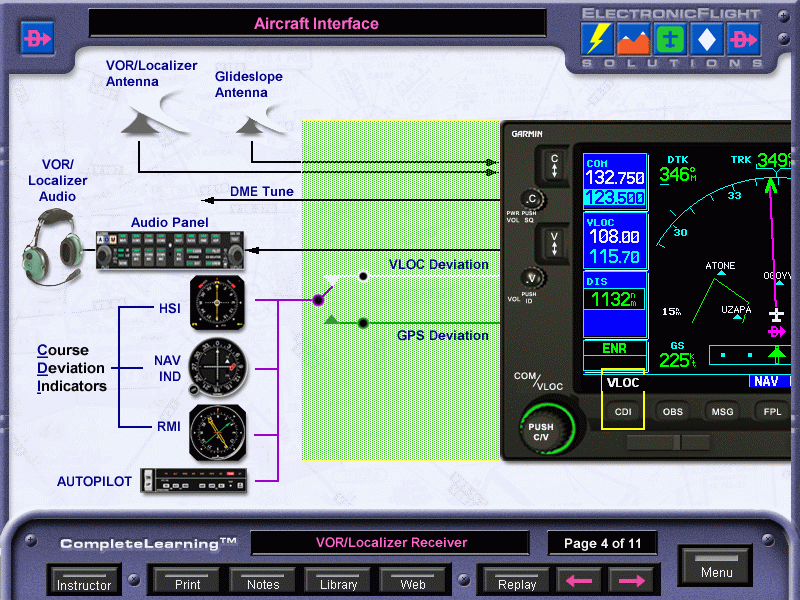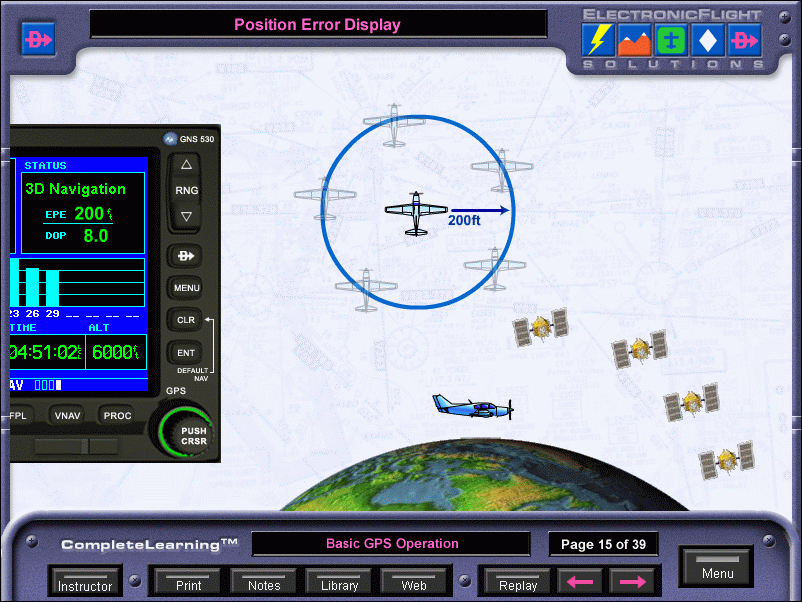Electronic Flight Solutions - Garmin GNS-530/GNS-430 Computer-Based TrainerClick here to purchase or contact the seller of this item on eBay |

|
|
| Current Price: 109.95 USD |

 |
Earn Wings Credit with this course! |
| Certainly one of the most innovative products is the Garmin GNS 530 and 430 IFR certified GPS/Nav/Com. These systems include a vast amount of capabilities, including full color moving map and MFD capabilities. However, the highly capable nature of this new equipment also creates an overload of information that some pilots are having difficulty absorbing. While the 200+ page Garmin Pilot Guide should be utilized in the cockpit as a reference, it leaves much room for improvement when training pilots on the efficient use of the GNS 530/430. | |
After successful completion of this training module, the operation and familiarity of the Garmin GPS should become second nature when it counts the most under high-workload situations. At the very core of the self-paced CBT (computer-based training) program is the Electronic Flight Complete Learning Methodology that focuses on the following basic elements:
|
|
|
APPLICABLE UNITS TRAINED:
|
AVIONICS UNIT TYPE:
|
| Deploying a conceptual approach to training, the ElectronicFlight CompleteLearning Garmin GPS Navigation module represents a breakthrough in effective GPS education. In the past, much of the GPS training concentrated on memorizing lengthy procedures, a rote approach. In studies looking into the effect of rote training on long term recall and problem solving, the rote method falls short in preparing the pilot to solve problems or work new processes into the ever-changing environment of aviation. Conceptual training, on the other hand, provides the tools that allow the creation of new procedures on the fly, to solve the problem at hand. | |
| To achieve the goal of conceptual training, the Complete Learning Garmin GPS Navigation module teaches common tasks using a building block approach. By teaching common tasks, the individual tasks can be combined to form any long procedure. Therefore, the pilot only needs to learn a few common tasks and also the reasoning behind the use of those tasks. No more endless and complicated procedures to learn, and forget, just a few small procedures that are retained in memory much longer. |
 |
| The training teaches the philosophy behind every button and
function. It also teaches how to navigate through the various
screens of the Garmin GPS. This gives a pilot the tools to perform
any function, even functions that were not intended by the engineers
that created the GPS. These may be new techniques compared to
typical training methods, but the research into the way people
really learn has found that conceptual techniques are superior for
problem solving and memory retention. |
|
 |
The GPS training program provides the tools to answer your own questions. Instead of "What is the procedure to do?" the tools allow a pilot to just answer the question at hand. This process is actually very quick. Once through this mental exercise the first time, the effort exerted to accomplish the lengthy task actually forces the knowledge directly into long-term memory. Much better than just dumping a procedure into short-term memory and hoping it eventually works its way into long-term memory after multiple practice sessions. |
|
Highlights of Electronic Flight Complete Learning GPS Module:
|
|
|
Training Credit 8 hours:
|
Minimum Computer System Requirements:
|
|
This system was developed by Paul Novacek, President of Sun Flight Avionics Paul earned a Masters Degree of Aeronautical Science in Human Factors from Embry-Riddle Aeronautical University, and actually wrote his thesis on GPS Pilot Training Methods. Involved with aviation his entire life, he earned a Bachelors degree in avionics from Embry-Riddle and worked as an avionics technician/system designer for 15 years. Paul was recently a Research Project Manager for NASA Langley facility in Hampton, Virginia. He is an aviation writer for Avionics News, FAA Aviation News, AvWeb and AOPA Pilot magazines. Paul is also an avionics systems test pilot, Master Flight Instructor and A&P technician. He has been teaching avionics as a flight instructor, lecturer and university professor since the mid 1980s. Most recently, Paul was Vice-President of Electronic Flight Solutions, where he developed a complete line of computer-based avionics training programs and managed a team of curriculum developers. He then developed many of the Jeppesen computer-based avionics training programs. Paul is currently a Program Manager for Flight Safety International in the Ft. Worth Bell Helicopter Learning Center, developing and maintaining all the training material for the Bell Helicopter programs. Additionally, Paul is president of Sun Flight Avionics where he continues to develop new training software for both the public and for private companies. |
|
|
|
Click here to purchase or contact the seller of this item on eBay
